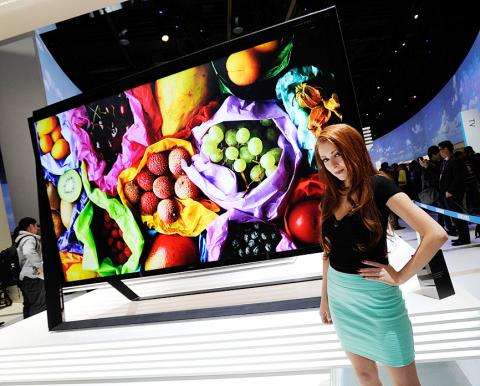The world’s biggest gadget show ended in Las Vegas on Friday and, like a prophet in the desert, revealed the future: bigger televisions, smarter watches, thinner humans and bendy phones.
That, at least, was the vision peddled by technology companies that unveiled 20,000 products over five frenzied days of networking and promotion at the Consumer Electronics Show (CES). About 150,000 industry professionals sifted through gadgets sublime and ridiculous, pointless and ingenious, seeking the next big innovation that will change the way we work, live and play.
Some ideas that provoked guffaws and headlines — the vibrating fork which chastises you to eat slower, the i-potty training system to keep your toddler on the bowl — may not endure, but others seemed certain to have a future.

Photo: AFP
Samsung, Sony, Toshiba and other television manufactures unveiled bigger screens — ranging from 50 to 110 inches — with “ultra-high-definition” four times sharper than traditional HD. Prices range from US$20,000 upwards.
2D prototypes marked the quiet death of 3D television, a much-hyped innovation at last year’s CES that flopped in stores. The technology may resurrect if the likes of StreamTV Networks convince consumers to buy 3D TVs, due out later this year, which do not require glasses.
Pebble, a kickstarter darling, won instant acclaim by unveiling a much-ballyhooed smart watch with e-paper display that connects to a smartphone and can receive e-mails, control music and track your movement. Priced US$150, there are 85,000 pre-orders.
“We had to get it right, it’s on your wrist,” Pebble founder Eric Migicovsky said. “People won’t tolerate something bad being attached to their body.”
The show signaled an accelerating drive by tech firms to sell the idea that technology is key to mental and physical well-being, with a quarter of displays devoted to gadgets for losing weight, getting fitter and improving health.
They harnessed smartphones and tablets to “wearable” fitness devices that monitor your exertions and store them in the cloud. Diabetics were offered apps to monitor their condition.
“It’s an inherently data-driven activity,” Joseph Martorano of iHealth said.
Samsung unveiled a prototype phone — super-thin plastic replaces traditional glass — which lets you fold it almost like paper. The technology, called Youm, will spread to other devices.
However, all the gadgetry did not dispel doubts that the expo is losing relevance. The event focused on hardware in a software-obsessed world and contained no major surprises. Some tech gurus declared CES a dying giant. True or not, the hordes leaving Las Vegas with their bags of freebie “swag” were happy.

TAKING STOCK: A Taiwanese cookware firm in Vietnam urged customers to assess inventory or place orders early so shipments can reach the US while tariffs are paused Taiwanese businesses in Vietnam are exploring alternatives after the White House imposed a 46 percent import duty on Vietnamese goods, following US President Donald Trump’s announcement of “reciprocal” tariffs on the US’ trading partners. Lo Shih-liang (羅世良), chairman of Brico Industry Co (裕茂工業), a Taiwanese company that manufactures cast iron cookware and stove components in Vietnam, said that more than 40 percent of his business was tied to the US market, describing the constant US policy shifts as an emotional roller coaster. “I work during the day and stay up all night watching the news. I’ve been following US news until 3am

UNCERTAINTY: Innolux activated a stringent supply chain management mechanism, as it did during the COVID-19 pandemic, to ensure optimal inventory levels for customers Flat-panel display makers AUO Corp (友達) and Innolux Corp (群創) yesterday said that about 12 to 20 percent of their display business is at risk of potential US tariffs and that they would relocate production or shipment destinations to mitigate the levies’ effects. US tariffs would have a direct impact of US$200 million on AUO’s revenue, company chairman Paul Peng (彭雙浪) told reporters on the sidelines of the Touch Taiwan trade show in Taipei yesterday. That would make up about 12 percent of the company’s overall revenue. To cope with the tariff uncertainty, AUO plans to allocate its production to manufacturing facilities in

Six years ago, LVMH’s billionaire CEO Bernard Arnault and US President Donald Trump cut the blue ribbon on a factory in rural Texas that would make designer handbags for Louis Vuitton, one of the world’s best-known luxury brands. However, since the high-profile opening, the factory has faced a host of problems limiting production, 11 former Louis Vuitton employees said. The site has consistently ranked among the worst-performing for Louis Vuitton globally, “significantly” underperforming other facilities, said three former Louis Vuitton workers and a senior industry source, who cited internal rankings shared with staff. The plant’s problems — which have not

COLLABORATION: Given Taiwan’s key position in global supply chains, the US firm is discussing strategies with local partners and clients to deal with global uncertainties Advanced Micro Devices Inc (AMD) yesterday said it is meeting with local ecosystem partners, including Taiwan Semiconductor Manufacturing Co (TSMC, 台積電), to discuss strategies, including long-term manufacturing, to navigate uncertainties such as US tariffs, as Taiwan occupies an important position in global supply chains. AMD chief executive officer Lisa Su (蘇姿丰) told reporters that Taiwan is an important part of the chip designer’s ecosystem and she is discussing with partners and customers in Taiwan to forge strong collaborations on different areas during this critical period. AMD has just become the first artificial-intelligence (AI) server chip customer of TSMC to utilize its advanced